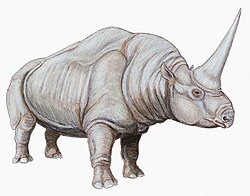| Acritohippus Temporal range: Miocene | |
|---|---|
 | |
| A. isonesus skeleton | |
| Scientific classification | |
| Kingdom: | Animalia |
| Phylum: | Chordata |
| Class: | Mammalia |
| Order: | Perissodactyla |
| Family: | Equidae |
| Subfamily: | Equinae |
| Genus: | † Acritohippus Kelly, 1995 |
| Species | |
| |
Acritohippus is an extinct genus of Miocene area equine from North America. [1] Fossils of Acritohippus have been found in Florida, [2] [3] New Mexico, [4] Montana, [5] California, [6] [7] and Oregon, where its fossils were first unearthed and described as a species of Merychippus back in 1928. [8] [9] [10] It was a grazer that ate C4 grasses. [11] [12] [13]








